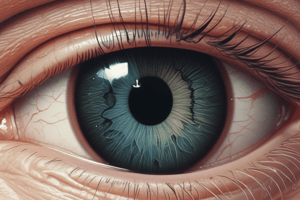Podcast
Questions and Answers
Which of the following groups of antimicrobial agents is primarily effective against trophozoites, but not cysts?
Which of the following groups of antimicrobial agents is primarily effective against trophozoites, but not cysts?
- Aminoglycosides (correct)
- Imidazoles/triazoles (correct)
- Biguanides
- Diamidines (correct)
What is the mainstay of pharmacologic treatment for infections affecting cysts and trophozoites?
What is the mainstay of pharmacologic treatment for infections affecting cysts and trophozoites?
- Aminoglycosides
- Diamidines
- Biguanides (correct)
- Imidazoles/triazoles
What should be avoided in the treatment of infectious conjunctivitis and keratitis?
What should be avoided in the treatment of infectious conjunctivitis and keratitis?
- Topical biguanides
- Antimicrobial agents
- Early referral
- Steroid eyedrops (correct)
When dealing with ophthalmia neonatorum, what is the recommended course of action?
When dealing with ophthalmia neonatorum, what is the recommended course of action?
What are signs that would warrant early referral in patients with eye conditions?
What are signs that would warrant early referral in patients with eye conditions?
Which of the following is NOT a recommended topical agent for treatment?
Which of the following is NOT a recommended topical agent for treatment?
In the context of pharmacologic treatment, what is true about biguanides?
In the context of pharmacologic treatment, what is true about biguanides?
What should be done for eyes showing misalignment or abnormal reflex?
What should be done for eyes showing misalignment or abnormal reflex?
Which category of antimicrobial agents includes chlorhexidine?
Which category of antimicrobial agents includes chlorhexidine?
What is indicated by the presence of an abnormal white reflex in the eye?
What is indicated by the presence of an abnormal white reflex in the eye?
Flashcards are hidden until you start studying
Study Notes
Diseases of Eyelid
- Blepharitis: Inflammation of the eyelid margin causing redness, irritation, and itchy eyelids; leads to dandruff-like scales on eyelashes.
- Causes: Can be bacterial (e.g., staphylococcal) or dermatologic (e.g., seborrheic dermatitis). Non-contagious, affects all age groups.
- Classification:
- Anterior blepharitis: Involves eyelid skin and lash roots.
- Staphylococcal: Primary bacterial cause.
- Seborrheic: Related to scalp dandruff.
- Posterior blepharitis: Affects meibomian glands; can cause dry eye syndrome.
- Mixed blepharitis: Combination of both anterior and posterior types.
- Anterior blepharitis: Involves eyelid skin and lash roots.
Demodectic Blepharitis
- Cause: Infestation by Demodex folliculorum, common in the elderly.
- Symptoms: Little to no inflammation, characterized by waxy, cylindrical cuffs around eyelashes.
Meibomian Gland Dysfunction (MGD)
- Impact: Blocked oil glands lead to poor tear quality, redness, and irritation.
- Signs: Irregular lid margins, prominent blood vessels, blocked gland orifices.
- Management:
- Lid hygiene with warm compresses.
- Oral tetracyclines or doxycycline for 4-6 weeks to reduce bacterial lipase production.
- Temporary treatments include lubricants.
- Surgery may be needed for definitive treatment.
Trichiasis
- Definition: Misdirection of eyelashes rubbing against the eye, causing irritation, tearing, and redness.
- Causes: Chronic blepharitis, herpes zoster, trachoma, or secondary to trauma.
- Treatment:
- Epilation for few lashes or more extensive treatment like electrolysis or surgery for severe cases.
Ptosis
- Definition: Abnormal drooping of the upper eyelid.
- Classification:
- Congenital: Present at birth.
- Mechanical: Due to lid edema or mass.
- Neurological: Associated with 3rd nerve palsy or Horner’s syndrome.
- Myogenic: From conditions like Myasthenia gravis.
- Aponeurotic: Most common, often age-related.
Keratitis
- Bacterial Keratitis: Common, managed with topical fluoroquinolones. Drugs include vancomycin for Gram-positive bacteria, tobramycin for Gram-negatives.
- Fungal Keratitis: Less common, more prevalent in humid conditions. Main risk factors are corneal trauma and contact lens wear.
- Symptoms: May present with fewer early signs but often has severe pain.
- Management:
- Topical treatments include diamidines, biguanides, imidazoles/triazoles; biguanides are effective against cysts and trophozoites.
General Recommendations
- Treat ophthalmia neonatorum urgently.
- Avoid corticosteroid drops for infectious conjunctivitis and keratitis.
- Ensure early referral for traumatic eye conditions showing severe pain, vision reduction, or abnormal appearances.
Studying That Suits You
Use AI to generate personalized quizzes and flashcards to suit your learning preferences.




